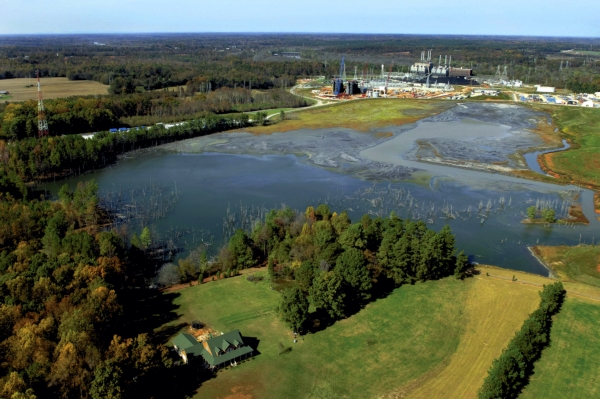Buck Steam Station’s coal ash ranked intermediate to low priority
Published 12:10 am Friday, January 1, 2016

- A November 2010 aerial photograph of the first holding basin that was being used to hold the coal ash from the coal-fired Buck Steam plant seen in the background. JON C. LAKEY / SALISBURY POST
DUKEVILLE — When state officials released a draft ranking of coal ash ponds across North Carolina, it wasn’t quite what environmentalists were expecting.
Coal ash ponds at Buck Steam Station on Thursday were rated at an intermediate to low priority — lower than a recommendation included in a previously leaked internal document. Buck and four other sites weren’t given an exact ranking — low, intermediate, or high — because of a lack of information, according to the Department of Environmental Quality. Specifically, the department lacked information about groundwater contamination, according to the rankings released Thursday.
In its rankings, DEQ staff wrote “Duke had failed to provide sufficient information for some impoundments to support a definitive conclusion as to whether the exceedances of groundwater standards near the coal ash impoundments are the result of natural background.”
Since spring 2015, when well water testing started, a significant portion of discussion about potential coal ash contamination in the rural Dukeville community has revolved around whether heavy metals found in test results are naturally occurring. More than 90 percent of water wells in the Dukeville community failed the state’s water quality tests earlier this year. Elements responsible for the failed tests, however, can be found in Rowan County’s soil and in municipal drinking water.
An internal document leaked in December by the Southern Environmental Law Center ranked most coal ash ponds across the state, including Buck, as high-risk sites. Buck and four others — Allen Steam Station in Belmont, Belews Creek in Stokes County, Marshall in Catawba County and Cliffside in Cleveland and Rutherford counties — received an intermediate to low ranking because of the lack of information, according to Thursday’s announcement. A high-priority ranking requires coal ash excavation by 2019. Intermediate-priority sites also require excavation, but with a 2024 deadline.
Yadkin Riverkeeper Will Scott focused on Buck’s high priority ranking in the internal document when criticizing rankings for not going far enough.
“It’s disappointing that DEQ political appointees in Raleigh chose to override their own regional staff’s designation of Buck as a high-risk site for groundwater contamination,” said Yadkin Riverkeeper Will Scott. “Instead, DEQ has followed Duke Energy’s flawed analysis. Even Duke’s hired engineers admit that we don’t have enough information to tell the full extent of groundwater contamination on the residential side of the site. With these levels of uncertainty, the state should look to protect the residents and the river — not Duke Energy.”
DEQ spokesman Mike Rusher said Dec. 8 marked the state’s deadline to receive information from Duke Energy. Rusher said DEQ has requested additional information about deficiencies in reports from the company. The information has been received and is currently being reviewed, he said.
DEQ’s rankings are classified as a draft. Buck Steam Station’s intermediate to low ranking could change as DEQ reviews follow-up information, Rusher said. A lengthy public input process will also affect the rankings. As part of the 2014 Coal Ash Management Act, public meetings must be held in each county where a coal ash pond exists.
In a statement released by Duke Energy, the company said it’s fully participating in the lengthy coal ash basin closure process and has “provided the state with the most in-depth science and engineering studies experts have ever done around North Carolina ash basins.”
“We want to ensure N.C. DEQ has the information it needs for its evaluation, so in addition to meeting our commitments under (the Coal Ash Management Act), we’ve also given regulators new and supplemental information that they’ve recently requested,” the company said in a statement released Thursday.
Although DEQ required additional information about groundwater at coal ash sites, the state agency concluded “no imminent threats to structural integrity were found. However, the state agency in 2014 issued structural deficiency notices for all three coal ash ponds at Buck Steam Station.
Frank Holleman, a senior attorney at the Southern Environmental Law Center, heaped criticism on DEQ for not following “science and common sense” in its draft rankings.
“Almost two years have passed since the Dan River spill and three years have passed since conservation groups woke up DEQ by theatening legal action to force a cleanup of these sites,” Holleman said in a prepared statement. “Yet, DEQ’s leadership still won’t take action to protect North Carolina. Politics has trumped science and common sense.”
Following Thursday’s draft rankings, the state must issue a written declaration within 30 days that provides documentation to support its proposed rankings. The 2014 Coal Ash Management Act requires DEQ to publish a summary of the declaration for three consecutive weeks in newspapers where a coal ash facility exists.
The declaration will be provided to each the Rowan County Health Department director and directors in other counties where coal ash ponds exist. It will also be available in a library in each county where a coal ash pond is located.
Public meetings in each county will end by March 31, 2016. Exact dates, however, haven’t be determined.
DEQ will issue its final classifications following completion of the public meetings. Its classifications will either become official within 60 days or head to the currently defunct Coal Ash Management Commission.
Contact reporter Josh Bergeron at 704-797-4246.




